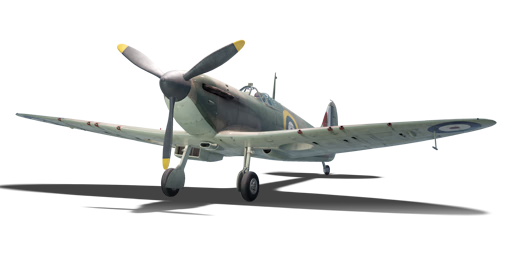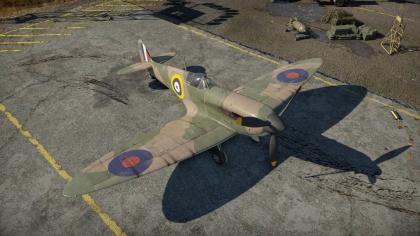Spitfire Mk Ia
Contents
| This page is about the aircraft Spitfire Mk Ia. For other uses, see Spitfire (Disambiguation) |
Description
The Spitfire Mk Ia is a Rank II British fighter
with a battle rating of 2.7 (AB), 3.0 (RB), and 2.3 (SB). It has been in the game since the start of the Open Beta Test prior to Update 1.29.
The Spitfire Mk Ia is one of the British tree line first monoplane designs, alongside the Hurricanes. The Spitfire is most distinctive with its sleek and thin elliptical wing design, a characteristic seen in most future Spitfire variants. The wing on the Spitfire is a Type A, as implied by the name "Mk Ia", which contained four .303 machine guns per wing with a total of eight machine guns.
Its default paint coat consists of a green and tan two-tone coloring, with a white undercoat. The Spitfire Mk Ia possess the Royal Air Force Type A.1 roundel on the fuselage with a yellow outer ring, followed by blue, white, and then a red center. On the wings, the Type B roundels are painted with a simple blue outer ring and a red center. The red, white, blue fin flap exist on the tail vertical stabilizer.
General info
Flight Performance
| Characteristics | |||||||
|---|---|---|---|---|---|---|---|
| Stock | |||||||
| Max Speed (km/h at 4,267 m) |
Max altitude (meters) |
Turn time (seconds) |
Rate of climb (meters/second) |
Take-off run (meters) | |||
| AB | RB | AB | RB | AB | RB | ||
| 523 | 508 | 10,000 | 16.9 | 17.7 | 7.5 | 10.8 | 300 |
| Upgraded | |||||||
| Max Speed (km/h at 4,267 m) |
Max altitude (meters) | Turn time (seconds) | Rate of climb (meters/second) |
Take-off run (meters) | |||
| AB | RB | AB | RB | AB | RB | ||
| 619 | 584 | 10,000 | 14.7 | 15.0 | 30.0 | 19.5 | 300 |
Details
| Features | ||||
|---|---|---|---|---|
| Combat flap | Take-off flap | Landing flap | Air brakes | Arrestor gear |
| ✓ | ✓ | ✓ | X | X |
| Limits | ||||
|---|---|---|---|---|
| Wing-break speed (km/h) |
Gear limit (km/h) |
Combat flap (km/h) |
Max Static G | |
| + | - | |||
| 760 | 270 | 290 | ~14 | ~8 |
| Optimal velocities | |||
|---|---|---|---|
| Ailerons (km/h) |
Rudder (km/h) |
Elevators (km/h) |
Radiator (km/h) |
| < 321 | < 400 | < 465 | > 250 |
| Compressor (RB/SB) | ||
|---|---|---|
| Setting 1 | ||
| Optimal altitude | 100% Engine power | WEP Engine power |
| 4,900 m | 1,020 hp | 1,357 hp |
Survivability and armour
- 38 mm Bulletproof glass - Armored windscreen
- 4 mm Steel - Armor plate in pilot's seat
- 6-7 mm Steel -Armor plate behind the pilot
Armaments
Offensive armament
The Spitfire Mk Ia is armed with:
- 8 x 7.7 mm Browning machine guns, wing-mounted (350 rpg = 2,800 total)
Notes:
- 153 rounds per second total output (1150 rpm x 8 / 60).
- Muzzle velocity 2,660 feet/second [810 m/s]. [1]
- The .303 was a rifle round, accurate but fairly ineffective in air combat unless in skilled hands. The calibre was chosen over the .50 as it was lighter, had a higher rate of fire and was less susceptible to jamming. However, it required an average 4500 rounds to disable an enemy aircraft [2], of which 250 rounds needed to hit (i.e. a full 2-second burst). Accurate placing of the shot was essential, as it lacked sufficient energy to cause structural damage.
- The design used an open bolt mechanism to allow air to flow through the barrel and prevent overheating. This worked well at lower altitudes, but caused icing at high altitude. The red canvas wing-port covering kept the gun clean and warm; later marks also ducted hot air from the engine to regulate the breech temperature. [3]
- RAF recommended convergence in 1939 was 400 yards [365 meters] in contrast to the Luftwaffe, with experience from the Spanish Civil War, using 200 meters (which the RAF adopted by mid-1940). Although many high scoring pilots reduced this, closing to 150 yards [137 meters] or less for an accurate kill, others ignored convergence altogether or went to a box-shot where paired guns were set to different convergences.
- Choice of ammunition is essential as AP and ball rounds rely on kinetic energy to cause damage, which is lost quickly in small calibre rounds. The API round will also transfer chemical energy into the target and so will be more effective on lightly armoured targets, particularly if they hit something flammable. Pure tracer rounds help targeting, especially in combat manoeuvres where lead varies, but have little penetration on contact. [4]
Usage in the battles
In 1940, in the Battle of Britain, the Spitfire flew to intercept enemy fighters because of its speed and agility, while the Hurricanes were sent to destroy the German Heinkel Bombers. This same logic can be applied to War Thunder Realistic Battles: the Spitfire should first climb, using its excellent rate-of-climb, then intercept high patrolling fighters, if possible, bringing them lower. The Spitfire is fast, with a top speed of around 600 kph, although in a straight line it normally only reaches around 460 kph. Do not engage head-on in the Spitfire. Doing so can destroy your engine, and your gun convergence won't save you. Avoid head-on engagements and go for turn fights. A sensible opponent will try to energy fight you. To avoid destruction, climb quickly away from them, then dart back into their trajectory arc, normally underneath them (high yoyo). You can perform this manoeuvre easily since you have a good lift rate. Eventually the opponent will miss and/or overshoot, allowing you to destroy them, or will dive, which you can follow. But be careful. The Spitfire will wing rip at around 500 kph or less, so don't pull hard or your wings will fly away...
The Spitfire has a relatively good ammo count. The 4-digit ammo can be deceiving, since there are 8 guns on the aircraft, making only around 400 rpg. You can use this to ground attack light or un-armoured targets, usually with stealth or omni-purpose belts, but this job should be left to dedicated gun-platforms, like the Hurricane and Hellcat.
When in a fight with an enemy plane which is not Japanese, proceed to entice them into a turn fight. Wait until they get close enough and then turn into them, forcing a turning fight.
The Spitfire Mk Ia is a plane known for it's manoeuvrability. It is faster than Japanese planes, so if attacked by one, either use a Rolling Scissors technique or just fly away. If in a good position, Boom & Zoom it.
Specific enemies worth noting
- Japanese planes - The Japanese fighter planes like the Ki-43 and A6M will turn all over the Spitfire. As such, do not exploit the Spitfire's turning ability against a Japanese opponent. Instead, use the Merlin engine power on the Spitfire to try and outrun the Japanese plane. When attacking Japanese plane, try to use Boom-N-Zoom tactics rather than turning to keep an energy advantage over the opponent.
- Biplanes - Biplanes may be slow, but they are among some of the most maneuverable aircraft in War Thunder. You must not try to turn fight them. Instead, climb or dive away from them and then use Boom-N-Zoom tactics. Luckily, biplanes are fragile and your eight machine guns will tear them apart.
- Heavy Bombers - Although you have eight machine guns, they are only 7.7 mms. With larger aircraft, you may find yourself expending all of your ammunition and not even coming away with a kill. The Spitfire is also quite fragile. You need to be careful of defensive turrets. Even light machine guns can take out your engine, kill your pilot and destroy combat surfaces.
Manual Engine Control
| MEC elements | ||||||
|---|---|---|---|---|---|---|
| Mixer | Pitch | Radiator | Supercharger | Turbocharger | ||
| Oil | Water | Type | ||||
| Controllable | Not controllable | Not controllable | Not controllable | Separate | Not ontrollable | Not controllable |
Modules
| Tier | Flight performance | Survivability | Weaponry | ||
|---|---|---|---|---|---|
| I | Fuselage Repair | Radiator | Offensive 7 mm | ||
| II | Compressor | Airframe | New 7 mm MGs | ||
| III | Wings Repair | Engine | |||
| IV | 100 Octane Fuel | Engine Injection | Cover | ||
Pros and cons
Pros:
- Good anti-fighter armament of eight machine guns that can shred them apart
- Outstanding turn time, very good at turning fights
- Good roll rate at low speed
- Good performance at low altitude, less than ~4.5 km
- Better-than-average top speed
- Better-than-average rate of climb
- Decent amount of armour, a front 38 mm glass and rear 4-7 mm steel plates
- 100 octane fuel modification provides roughly 15% increase in engine power
Cons:
- Machine guns only effective if target is hit in continuous bursts
- Machine gun armament lacks the long range hitting power of cannons
- Ammo can run out quickly in prolonged, uncontrolled bursts
- Wing-mounted armament takes wing convergence into consideration
- Quick kills against large bombers without a pilot snipe is difficult, prolonged engagements exposes the Spitfire to the defensive gunners
- Bad high altitude performance
- Roll rate stiffens dramatically at ~350 kph
- Not the best diver, wings tend to rip (RB/SB)
- Less-than-average energy retention
- Fragile construction, a damage to airframe, control surfaces, or engine can cripple plane
- Pulling Negative G's (realistic/simulator only) can cause the carburetor(engine) to fail!
History
Aces
The Spitfire Mk.1A was the iconic British aircraft of the Battle of Britain. Leading Spitfire aces of this battle were: [5]
| Name | Nationality | Squadron |
|---|---|---|
| Pilot Officer Eric Lock | British | 41 |
| Flying Officer Brian Carbury | New Zealand | 603 |
| Pilot Officer Colin Gray | New Zealand | 54 |
| Pilot Officer Bob Doe | British | 234 |
| Flight Lieutenant Paterson Hughes | Australia | 234 |
Media
An excellent addition to the article will be video guides, as well as screenshots from the game and photos.
Read also
Links to the articles on the War Thunder Wiki that you think will be useful for the reader, for example,
- reference to the series of the aircraft;
- links to approximate analogues of other nations and research trees.
Sources
Paste links to sources and external resources, such as:
- topic on the official game forum;
- page on aircraft encyclopedia;
- other literature.
- ↑ http://www.aviation-history.com/guns/303.htm
- ↑ Flying Guns: World War II by Anthony G Williams, Emmanuel Gustin (2003), p95
- ↑ https://en.wikipedia.org/wiki/Supermarine_Spitfire#Armament
- ↑ http://users.skynet.be/Emmanuel.Gustin/fgun/fgun-fi.html
- ↑ https://en.wikipedia.org/wiki/The_Few





